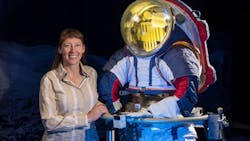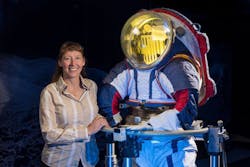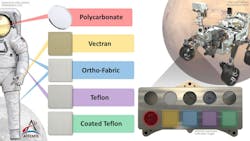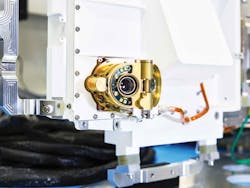Just-Launched Mars Rover Will Test Spacesuit Materials
Planners at NASA are using the just-launched Martian rover, Perseverance, to test materials that could be used on spacesuits for future missions to the Moon and Mars. So, as the 2,300-lb robot moves across the planet, it will carry five small samples of materials that could be used in future spacesuits for lunar or Martian missions. On the rover, they will all be exposed to the ambient atmosphere and conditions on Mars.
Fire-resistant Nomex, waterproof-but-breathable Gore-Tex and super-strong Kevlar are combined to make ortho-fabric. NASA has lots of experience using ortho-fabric on spacesuit exteriors. Vectran resists cuts and is used on the palms of gloves worn with spacesuits. It has come in handy on the space station where handrails along the exterior get struck by micrometeoroids. This creates small, sharp pits which can cut weaker materials.
Polycarbonate is often used on transparent helmet visors and bubbles for a its ability to cut down UV light. It also does not shatter, instead it bends a little. Teflon has also seen lots of service on space suits as several parts of the glove. It’s inherently “slippery,” making it less likely to catch and tear. NASA included a sample of plain Teflon and some with a dust-resistant coating.
Dust can be a problem. For example, current spacesuits are inflated to about 4 psi. That makes them stiff and difficult for astronauts wearing them to move around. To make things easier for the astronauts, NASA equips the bearings on the suit’s joints at the shoulders, wrists, hip, upper thighs and ankles with special seals for keeping dust out.
NASA is looking for other ways to protect spacesuits from dust for long-duration missions. Its engineers know that a coated or film material is better at keeping out and repelling dust than woven materials with spaces between yarns. The two Teflon samples will let NASA evaluate the dust-resistant coating’s usefulness.
Periodically, the samples will be scanned by a device called SHERLOC (Scanning Habitable Environments with Raman and Luminescence for Organics and Chemicals). The 7-lb device on the end of Perseverance’s robotic arm uses spectrometers, a laser and a camera to examine minerals, organic molecules and potential signs of life. The laser, for example, uses Raman spectroscopy to detect and identify minerals in microscopic rock features. This data will be used to determine where the rover will drill for further rock samples.
Alongside the spacesuit material samples, NASA is including a fragment of a Martian meteorite. NASA scientists will image it with SHERLOC to ensure the instrument’s settings are correct, comparing readings on Mars to base-level readings they got on Earth.
SHERLOC can determine the composition of Martian soils and it does the same for the spacesuit materials. Prior to the mission, NASA bathed identical samples in the radiation expected on Mars and analyzed their composition with instruments much like those on SHERLOC. The results of the lab tests will be compared to data gathered over time on Mars to give researchers an idea of how the samples are breaking down due to exposure
In an ambitious and somewhat audacious part of the mission, some of the freshly drilled rock samples, along with the samples of spacesuit materials, will be sealed in cans and held on the rover for a future Mars mission to retrieve and return them to Earth, where they will be further studied.
The retrieval mission currently calls for sending two unmanned spacecraft back to Mars in 2026. One spaceship would land near Perseverance. It would send out its own rover to meet up with Perseverance to collect the sample tubes. It would return to its spacecraft which would takeoff and go into orbit around Mars. A second spacecraft would rendezvous in orbit with the ascent vehicle, take the sample tubes onboard, then blast off for Earth.
According to NASA engineers, this approach is easier than designing a single spacecraft that could fly to Mars, land, pick up the tubes and fly back to Earth. The goal is to get the samples back to Earth in 2031.
This should be the first time anything has been brought back from Mars. It would also be the first time a piece of Mars, the frequent-flying meteorite, has gone from Mars to Earth, then back to Mars, and finally back to Earth.



